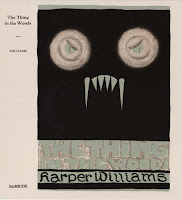Professor Roger Smith at literary
conferences liked to tell with impish humour of improbable authors such as Dame Lalage Ferris-Fermor,
the expert on Byzantine architecture and author of rococo novels.
And so when he spoke of E C Large,
the author of Sugar in the Air, about a scientist who discovers how to
distil a sweet sap from the atmosphere, and Asleep in the Afternoon, where
whole communities suddenly succumb to slumber, we suspected these were his inventions.
Ah yes, March of the Mushrooms,
he added, that was another of his: they’re taking over you know, they’ll be here
when we’re long gone. This with a slow thoughtful nod.
The first two titles turned out
to be true. They are excellent 1930s scientific romances, imaginative and enjoyably eccentric, which both reflect the inevitable influence of Wells but also look forward to the 'cozy catastrophes' of John Wyndham.
But it was a while before we found out about the third, which sounded plausible, yet proved to be curiously elusive. This was because it was really
called The Advance of the Fungi (1950: the Professor’s title was better).
And it is not a novel, but a text book, thought it must be conceded that the
dustwrapper of the US edition (illustrated) does have a distinctly Wyndham-ish
look to it.
There is a diagram in it of the millions of years
when the fungi ruled all, with just a sliver of human time afterwards. Great arrows
then show the fungi overleaping this and
triumphing once again. The spores are
everywhere, that is clear.
The tree-stump saprophytes like pale
Gothic lords wait in their dank abodes, sating themselves on decay; the creeping
crimson vampire rust lingers on leaves, sucking out lives; the dandy toadstools
pose in masquerade. These are their days, as the book explains.
And there was a third novel, Dawn
in Andromeda (1956), about humans surviving on another planet as part of a
cosmic experiment. It turns out that humans will be humans, for good or ill,
wherever you put them. One copy available online has tipped-in to it “a fragment
of the original rhubarb papyrus” (presumably as featured in the story) with a
dedication from Large to a friend. There is a discussion of the book, and early
wireless and SF fans, by Charlotte Sleigh, at the Science Museum Journal.
Large was a plant scientist
specialising in the enemies of vegetation: he was also the author, with A E
Cox, of Potato Blight Epidemics Throughout the World (1960). The Large completist may be tempted even by this.
An excellent celebration of him, God’s
Amateur: The Writing of E C Large edited by Stuart Bailey and Robin
Kinross, was published by the Hyphen Press in 2008 (they have also reprinted
his first two novels).
It includes a study of his work, a bibliography, a
selection from his essays and papers, some reproduced in facsimile from his typescripts, and the
author’s own biographical note, which begins: ‘My concern with the fungi began
when I was a schoolboy . . .’
(Mark Valentine)






